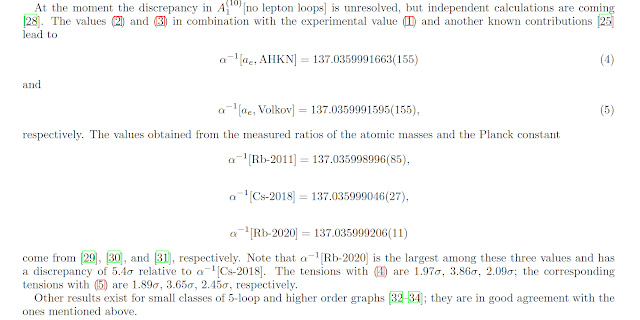The anomalous magnetic moments of the electron, the muon, and the tau lepton are global tests of the Standard Model of Particle Physics that implicate most parts of it, and can be both calculated and experimentally tested with exquisite precision in the case of the electron and muon anomalous magnetic moments. But calculating what value the experimental measurements of this are expected to produce is extremely involved and challenging, even when you are calculating only part of the multi-component calculation.
A new preprint claims that there is a 5 sigma error in the QED portion of the standard lepton g-2 calculation done in 2017 (an error which is still tiny since the calculation is so precise). The 5 sigma discrepancy between the two calculations, however, leaves no doubt that one of the two calculations is wrong. A third independent recalculation of the five loop QED part of lepton g-2 is underway and may resolve the discrepancy.
Since the uncertainty in the QED portion of the calculation is so small, however, this doesn't materially impact the total lepton g-2 calculations or the related calculation of the electromagnetic coupling constant which is functionally related to that calculation. The coupling constant calculations and three different leading experimental measurements of that coupling constant, are all identical to the first nine significant digits (basically, the differences are at a parts per billion level).
When it comes to calculating the predicted values of the experimental observables, uncertainties from the weak force and strong force contributions to the total value dwarf the uncertainties in the QED part of the calculation which is disputed in this preprint.
The body text of the introduction to the paper (reproduced in full below so that I don't have reproduce the delicate formatting of the equations involved) compares the old calculation, to the new calculation, to the experimental evidence for the electron g-2 case, but the QED part for the electron g-2 calculation heavily overlaps with the calculations for the muon and tau lepton cases.
The paper and its abstract are as follows:
The total 5-loop quantum electrodynamics universal contribution to the anomalous magnetic moments of the leptons was calculated by the author. The obtained value A(10)1=5.891(61) provides the first complete verification of the previously known value obtained by T. Aoyama, M. Hayakawa, T. Kinoshita, M. Nio (AHKN). The discrepancy is 5σ.
The computation includes the recalculation of the part that the author calculated in 2019 using a slightly different method and the calculation of the remaining part of the coefficient. A comparison with the AHKN values in 32 gauge-invariant classes is provided. In addition, the results are divided into 95 small gauge-invariant classes that subdivide the former ones. Such a detailzation is provided for the first time. The method described in previous works of the author was used in general. However, the Monte Carlo integration method is new and is described in detail. Some useful technical information and information on numerical cancellations is also given.
Sergey Volkov, "Calculation of the total 10-th order QED contribution to the lepton magnetic moments" arXiv:2404.00649 (March 31, 2024).



No comments:
Post a Comment